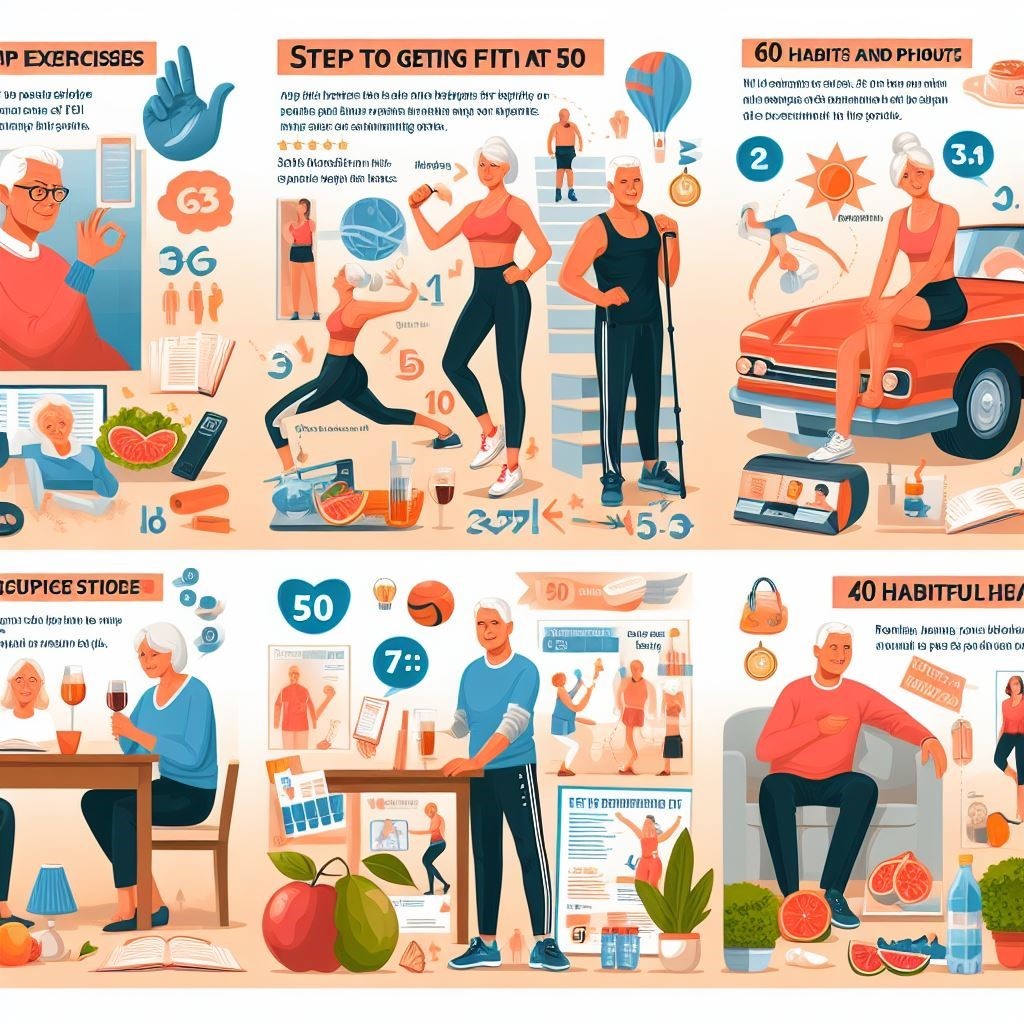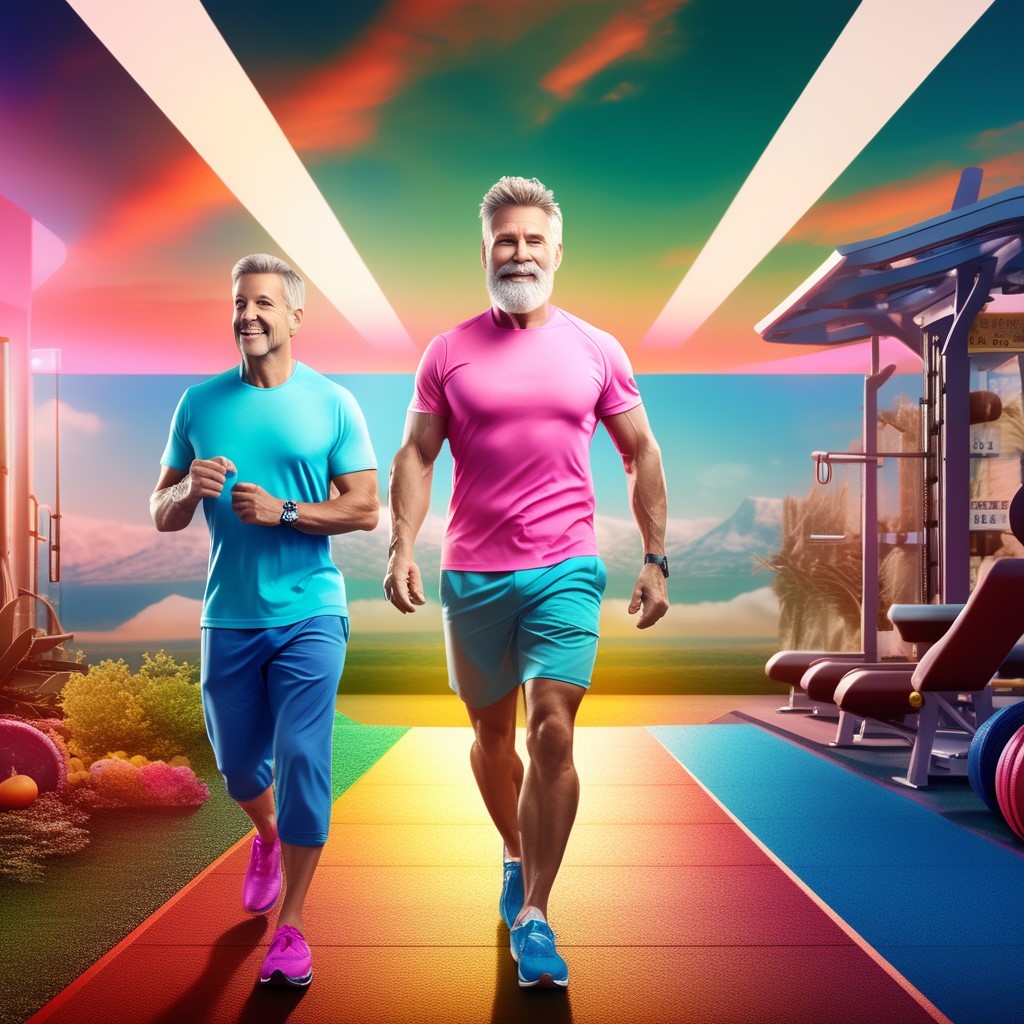How to Get Fit at 50: Ultimate Guide with the Best 10 Steps
Discover the ultimate guide on How to Get Fit at 50 with our top 10 steps. Achieve optimal health and fitness after 50 with expert tips and personalized advice.
Introduction
Reaching the age of 50 can seem daunting for many people. However, it doesn’t have to mean the end of being active and fit. Adjustments to your workout routine and lifestyle allow you to get fit and feel energized at 50 and beyond. Here is your ultimate guide on how to get fit at 50.
Top 10 Steps for How to Get Fit at 50

Let us dive into the best 10 steps for How to Get Fit at 50 as follows :
Step 1: Talk to Your Doctor
To kickstart your fitness journey at 50, the first crucial step is consulting with your doctor for medical clearance. This ensures your increased physical activity aligns with your health conditions. Your doctor can assess your fitness level, guide safe activities, and address any concerns. Don’t hesitate to ask questions and seek their approval, making your fitness journey at 50 both safe and rewarding. How to get fit at 50 begins with prioritizing your health through a doctor’s consultation.
Step 2: Start Slowly and Listen to Your Body
Getting fit at 50 requires a balanced approach to avoid overexertion. It’s crucial not to push yourself too hard initially, as this can lead to injuries and fatigue. Begin with a gradual increase in workout length and intensity. Pay attention to any signals of discomfort or pain, allowing your body the necessary recovery time. Incorporate rest days between workouts and address any sore muscles promptly. Starting slowly enables your body to adapt to new demands, building stamina over time. How to get fit at 50 involves a mindful progression to ensure a sustainable and injury-free fitness journey.
Step 3: Focus on Building Strength and Balance
Enhancing fitness after 50 involves two key components: building strength and improving balance. Strength training, focusing on major muscle groups, helps combat the natural decline in muscle mass associated with aging. Incorporate resistance bands, dumbbells, or weight machines 2-3 times per week to maintain muscle mass, boost metabolism, and burn calories.
Another vital aspect of how to get fit at 50 is addressing balance. Balance tends to diminish as we age, increasing the risk of falls and injuries. Integrate balance exercises such as standing on one foot, walking heel to toe, and torso twists into your routine. Explore activities like Tai Chi, yoga, and Pilates to further enhance overall balance and stability. Prioritizing both strength and balance ensures a well-rounded approach to fitness after 50, promoting a healthier and more active lifestyle.
Step 4: Mix Up Your Cardio
In the quest for how to get fit at 50, don’t overlook the importance of aerobic activity or cardio, which plays a pivotal role in heart health and calorie burning. Engage in exercises you find enjoyable and keep things interesting by incorporating a variety of activities. Whether it’s brisk walking, cycling, swimming, or dancing, finding activities that resonate with you ensures a more sustainable and enjoyable fitness routine. Prioritize cardiovascular exercises to enhance your overall well-being and make the journey to fitness at 50 both beneficial and enjoyable.
. Successful options for cardio at 50 include:
- Walking – Start with short 10–15-minute walks and work up to 30-60 minutes most days of the week. Walking is low-affected and easy on your joints.
- Swimming – An excellent choice for joint pain since water bears your weight. Do laps or water aerobics classes.
- Cycling – Ride outdoors or use a stationary bike. Start slowly and work towards intervals or hills.
- Rowing – Uses all your major muscle groups and is an efficient calorie burner.
- Dancing – Choose styles you enjoy, like Zumba, salsa, hip hop, etc. Dancing works your whole body while being fun!
- HIIT workouts – short bursts of intense exercise followed by rest periods. Can use bodyweight moves or try a HIIT class. Start with 10-15 minutes.
Aim for 150 minutes of moderate cardio or 75 minutes of vigorous cardio per week. Listen to your body and take breaks when needed.
Step 5: Incorporate Flexibility Exercises
Maintaining flexibility is a key aspect of how to get fit at 50, as it tends to diminish with age. Incorporating stretching and mobility exercises into your routine is crucial. After each workout, take time to stretch all major muscle groups. This reduces muscle soreness and minimizes the risk of injury, ensuring a more effective and sustainable fitness journey. Prioritize flexibility to enhance overall mobility and well-being as you pursue fitness at 50. Some successful flexibility exercises include:
- Yoga – Hold basic poses like downward dog, child’s pose, and cat/cow pose. Focus on breaths.
- Foam rolling – Use a foam roller to massage tight spots and loosen muscles.
- Dynamic stretches – Move joints through a full range of motion, repetition with control.
- Static stretches – Hold a stretch for 30-60 seconds. Feel the stretch, don’t bounce.
Aim to stretch 3-5 days per week after workouts. This keeps your muscles long, loose, and limber. Increased flexibility equals better movement.
Step 6: Focus on Functional Fitness
Enhance your fitness at 50 with functional exercises—key for daily activities like rising from the floor, carrying groceries, or playing with grandkids. How to get fit at 50 involves building strength, balance, and coordination.
Some examples of functional fitness exercises include:
- Squats – Strengthen the lower body and improve the ability to lift objects.
- Pushups – Build upper body strength for tasks like carrying heavy bags.
- Planks – Improve core strength essential for posture, balance, and stability.
- Lunges – Target leg and glute strength needed for stairs, hills, or uneven terrain.
- Bicep curls – Boost arm strength for activities like lifting and carrying.
How to get fit at 50? Incorporate functional fitness into your routine 2-3 times a week, alongside cardio and stretching. Stronger muscles from functional workouts make everyday activities easier, creating a well-rounded and effective fitness approach.
Step 7: Improve Your Diet with Nutrition for Fitness Over 50
Getting to 50 involves more than just exercise; your diet also matters. Ensure enough protein for muscle health and opt for healthy fats. Reduce processed foods, salt, sugar, and saturated fats to minimize inflammation. Stay hydrated, listen to hunger cues, and avoid overeating for a holistic approach to fitness after 50.
Essential nutrition tips for getting fit over 50 include:
- Eat more veggies and fruits with vitamins, minerals, and antioxidants.
- Choose whole grains – Brown rice, oats, and quinoa have fiber for digestive health.
- Include fatty fish – Salmon, tuna, and sardines have anti-inflammatory omega-3s.
- Drink less alcohol – Limit to 1 drink per day for women and 2 for men.
- Take supplements – calcium, Vitamin D, magnesium, and protein powder. Discuss with your doctor.
Eating well nourishes your body, so you have energy for your workouts and recover optimally. Consult a registered dietitian if you need help to improve your diet.
Step 8: Get Plenty of Rest and Recovery
How to get fit at 50? Prioritize rest and recovery. After 50, your body needs extra time to repair. Aim for 7-9 hours of quality sleep with a consistent routine. Minimize screen time and caffeine, and create a conducive sleep environment for optimal recovery.
Listen to your body’s signals for when to take a rest day from working out. Massage, stretching, meditation, and Epsom salt baths also aid recovery. Don’t forget active recovery like walking, yoga, or foam rolling.
Getting proper rest ensures your body can keep adapting and getting stronger when you are over 50. Recovery is where the fitness magic happens!
Step 9: Track Your Progress
Tracking your progress as you get fit after 50 can be helpful. Use a journal to record your workouts, reps/sets completed, distance, times, heart rate, and how you felt during the workout.
Tracking helps you see improvements, so you stay motivated. You can also see if you need to adjust to prevent plateaus.
Other ways to track progress include:
- Before and after photos – successful for seeing muscle tone and fat loss changes.
- Measurements – Use a tape measure around arms, waist, hips, thighs, etc.
- Fitness tests – Pushups in a minute, one-mile walk time, flexibility tests. Compare results.
- Fitness devices – heart rate monitors, pedometers, sleep trackers. Give insights into workouts.
Review your progress periodically. This keeps you accountable and focused on achieving your fitness goals.
Step 10: Get Support and Stay Motivated
Making a big lifestyle change, like getting fit at 50, is not always easy. When motivation lags, it helps to have a strong support system. Surround yourself with positive people who encourage your efforts. Consider hiring a personal trainer or working with a fitness buddy.
How to get fit at 50? Stay focused on meaningful goals like energy for travel, keeping up with grandkids, or feeling confident. Make fitness part of your identity by prioritizing exercise in your schedule.
Other tips for staying motivated include:
- Mix up workouts to prevent boredom – Try new equipment, classes, videos, and locations.
- Set short-term rewards for meeting goals – new workout gear, massage, weekend trip.
- Remind yourself how exercise benefits you – Reduced stress, better sleep, health protection.
- Focus on feeling successful after workouts – The release of endorphins gives you positive energy.
Staying motivated is essential to maintain your new fit lifestyle. How to get fit at 50 becomes achievable with consistency and dedication. Remember, the key to success in getting fit over 50 lies in staying motivated and staying consistent with your efforts.
Key Takeaways for How to Get Fit at 50

- Get medical clearance before starting a new workout routine.
- Begin slowly and accumulate duration and intensity.
- Focus on strength training, balance exercises, and cardio.
- Stretch regularly to improve flexibility.
- Incorporate functional fitness moves.
- Improve nutrition with whole foods and stay hydrated.
- Allow proper rest and recovery time for your body.
- Track progress with photos, measurements, and fitness tests
- Get support from family, friends, trainers, or fitness buddies.
- Stay motivated by mixing up workouts, tracking progress, and focusing on results.
How to get fit at 50? Start with sustainable, small steps, be patient, and listen to your body. Achieving fitness over 50 enhances your health, energy, and overall life participation. Consistency and personalized programming ensure outstanding fitness results tailored to your needs.



